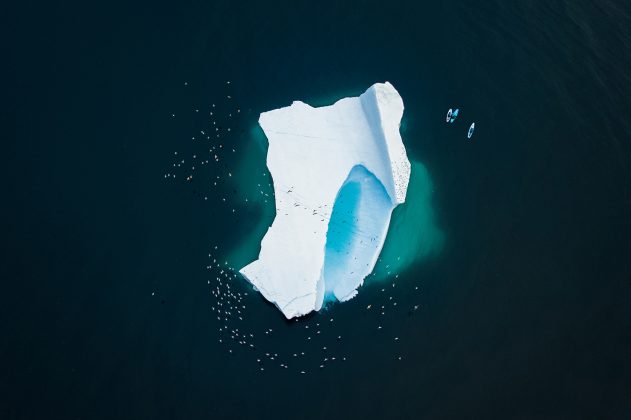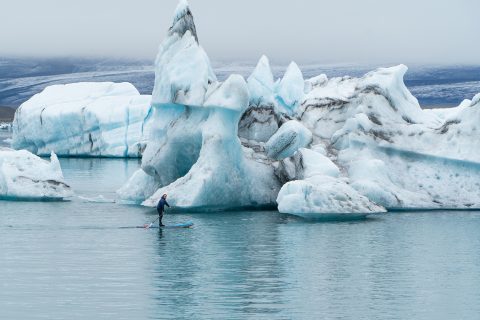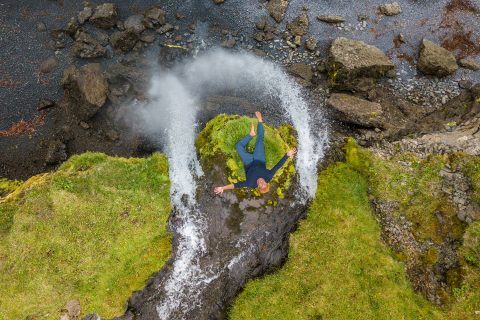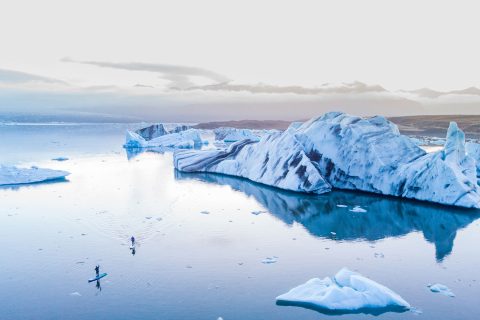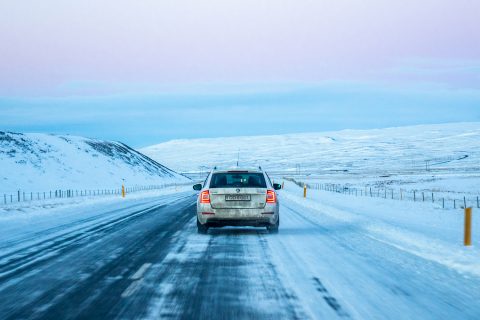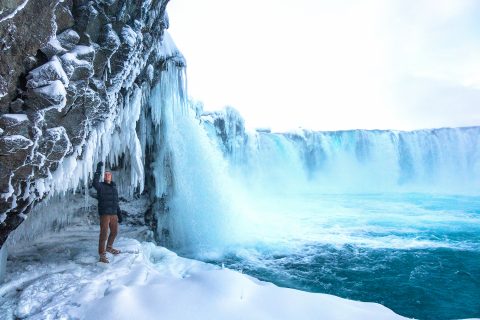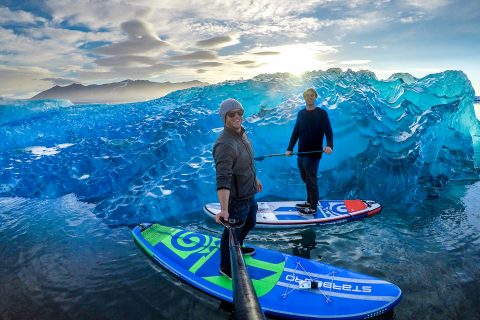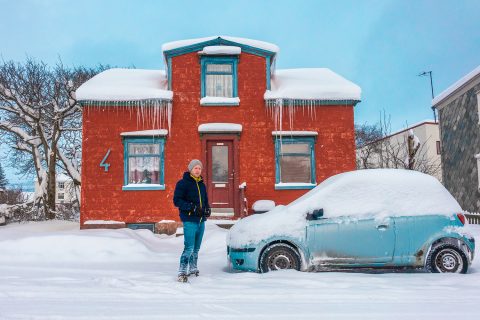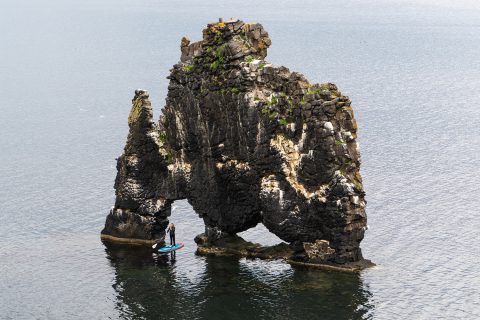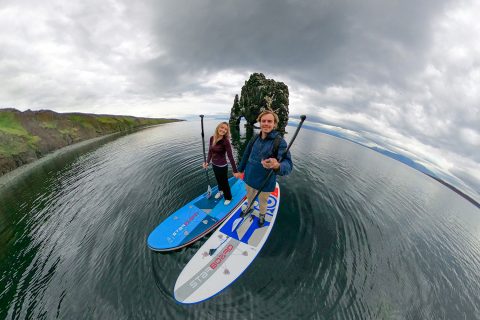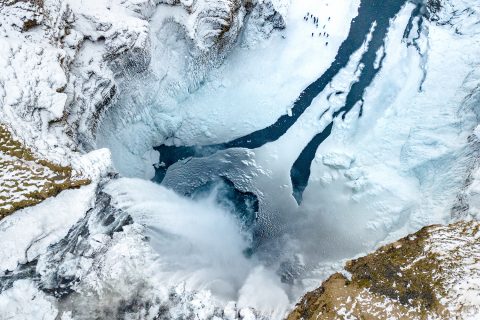FIRE AND ICE: ICELAND
Trevor Tunnington recounts four separate missions to Iceland and how this amazing country literally changed his life!
Words: Trevor Tunnington
Photos: Courtesy Trevor Tunnington
FIRST MISSION 2017
My obsession with Iceland began rather spontaneously back in 2017. I was road tripping around Sweden with my friends, Emelie and Josie. Midway through our travels the weather turned on us, thunderstorms forecast for the whole second week. We needed to change plans… fast. That afternoon we were on the cheapest flight out of Stockholm – a €40 Wizz Air flight to Keflavík Airport, Iceland.
- Iceland!
And by evening we were driving out of the small airport, equipped with one tiny rental car and a 2-man tent that, in hindsight, was too small for three people. It wasn’t long before we realised that Iceland was an extraordinary place. Scenery would drastically change from mossy mountains to basalt beaches and jagged cliffs with waterfalls piercing through the rock. In Iceland during summer it never truly gets dark… and when we set up camp later that night, we were gifted with hours of pink sunset skies. The trip flew by faster than we could say “wow”.
We were immersed in nature like nothing I had experienced before. It wasn’t until our last afternoon that we really thought about our experiences in Iceland. Emelie, Josie and I sat on the beach of Sólheimajökull glacier lagoon, watching floating chunks of ice, illuminate in incredible aqua colours as the sunlight beamed through them. Staring and reflecting on the incredible natural beauty we had seen over the last few days… Eventually I broke the silence to ask the girls what they were thinking. Emelie was on her gap year, about to study medicine in a few short months. In that moment on the beach, she realised that her passion was not in medicine, but rather architecture. Sure enough Emelie changed her degree and studied architecture that next semester. Josie too had a realisation, like me Josie had no plans to study at university. Josie found her passion in Iceland, amazed by the rock formations and nature. The next day Josie signed up to a university course studying geology. I too had a realisation… I want to come back to Iceland every year until I have truly seen this country. Then it occurred to me that five days had flown by and I hadn’t taken a single photo. In fact I didn’t even own a camera. I took my first photo this trip – a phone photo of the glacier I had been staring at for hours.
I wanted to travel, take photos and create videos so I can relive rare experiences such as this very moment. Although I had no camera, I now had direction. Today I work as a videographer and photographer.
- Waterfal captured by drone
THE RETURN 2018
I returned to Iceland the following summer after purchasing a drone and a GoPro. This time I was joined with my friend’s Chris and Georgia. Chris is a long time travel nomad, on a mission to travel as much as he possibly can. Chris’s favourite country he has visited was Iceland. Georgia is a close friend of Emelie, so Iceland was of course highly recommended. We planned a ring road adventure, driving the entire coastal road around Iceland. This typically takes around twelve days. With clear skies forecast, we found a local supermarket that sold pop up tents (it was more of a beach tent but seemed to be strong enough) and we were on the road!
- Sup Iceland
Equipped with my new camera gear and three inflatable Starboard SUP’s we aimed for the incredible Iceberg lagoon named Jökulsárlón. We would not make it to Jökulsárlón on our first night, there were waterfalls and natural wonders to explore on the journey, so the first evening we set up camp near a local farm. That is when Chris spotted an object in the water. It was an iceberg! Iceland isn’t usually home to ocean icebergs as ocean temperatures are too warm. Icebergs in Iceland typically come from glaciers which drop chunks of ice into various lakes. This one was big… and it was definitely from Greenland. The enormous berg must’ve sailed around 1200km from Greenland. I sent the drone out to have a closer look…
- Exploring
It looked amazing. So, I returned the drone and we pumped our boards, embarking on our first iceberg exploration. Adrenaline was high as we edged closer to the berg. It creaked like an old sail ship in the open ocean and was about the height of a two-story building, even featuring its own swimming pool in the centre. We arrived near the berg at midnight and watched the sun kiss the horizon before rising once more. The light was amazing, the ocean was calm and it was time to get that drone in the sky. I shot some videos of us paddling along with a few photos, but after five minutes I noticed that the battery had dropped from 100% to around 35%. Hmmm…. strange. Seconds later I felt panic as the low battery beeping began, this meant that the drone was under 15% and should be returned as fast as possible. That is when I realised that drone batteries struggle in cold conditions; and the outside temperature was around 3 degrees celsius. We had planned for Chris to catch the drone from the SUP when it was time to land, but the sensors would not allow me to land – every time Chris tried to grab it the drone would pull up. After some screaming and moments of panic the drone dropped to 1% just as Chris managed to sneak his hand over the drone and snatch it out of the sky, sacrificing his finger on the process. He walked away with very mild finger injuries, but everybody will always be grateful for his bravery.
We barely got any sleep that night as our excitement was at an all-time high. There was more iceberg action to come the next day as we visited Jökulsárlón, AKA Iceberg Lagoon, which sits at the base of the Breiðamerkurjökull Glacier – which is on the south coast of Iceland and has been receding since the 1950s. As this Glacier receded, it dug away a 250m deep lagoon and the combination of the ocean and molten ice formed the half salt, half fresh-water lagoon. The most amazing part is the enormous chunks of ice that break off the glacier every day, creating this maze of icebergs. After a long day of driving, we arrived at the lagoon at around 8pm and began our paddle adventure. The sky was filled with rainbow colours as we paddled and thanks to the summer season, we knew that the sun would hardly set – it rather descends to the horizon and comes straight back up before setting. For around eight hours we paddled alongside Icebergs the size of apartment buildings, and smaller bergs rolling and cracking.
- Amazing Iceland
It’s important to keep your distance as 70% of the ice is below water. At one point we heard what sounded like a truck falling off a collapsing bridge – not to worry, it was a distant berg. The unpredictability was what I found most amazing. One moment I was staring at a seemingly harmless iceberg, bubbling at one. The next moment that same peaceful iceberg would let out a loud crack before snapping in two pieces and rolling over along with a mixture of rock and other sediment.
Our final Iceberg that day was one of my favourite icebergs. The 4am sun was beginning to rise from the horizon once again. We had just set up our campsite on the beach (for the morning) but noticed an iceberg roll over, the melted underside appeared polished. The light rays beamed through the berg, lighting it in an incredible turquoise colour.
The sun rose above the glacier and changed colours from turquoise to green.
- Stunning Icebergs
WINTER 2019
It was February 2019, winter in Iceland when I next returned. Days were very short – around four hours… Chris and I wanted to see if we could hunt the Aurora Borealis (northern lights). This time it was -25 Celsius some days so we wouldn’t be staying in our 40 euro tent. The scenery this time was magical, with sugar coated mountain ranges as far as you could see. On the other hand, other days featured intense blizzards with bad visibility. This was one of the most unpredictable seasons of the year, with blizzards and heavy snowfall spontaneously appearing without warning.
The following days we visited calm lakes on the south coast. Temperatures were cold, but the scenery was beautiful. I stopped by some lakes and took many more photos.
We made our way to Akureyri (Iceland’s second largest city after Reykjavik) where we had met some friendly locals the previous year. Akureyri is a friendly and modern town, however in the past this had been a whaling town. Today tourism is booming and whaling is much less common, so whale watching is a popular activity in summer months.
- Iceland
Akureyri is close to some incredible nature including my favourite waterfall in Iceland, Goðafoss. It was incredible to see Goðafoss in winter as half of the waterfall was frozen and formed icicles.
We did not see northern lights on our trip as most of the evenings were cloudy or foggy, although some nights we noticed a green glow through the clouds. Funny enough a few weeks later I was flying on a long-haul flight from London to Los Angeles and the plane flew over Greenland. In the middle of the night, I opened my window blind to check if the sun was coming up… the sky was clear and dark and suddenly rivers of aurora blasted through the sky. The magical show lasted around half an hour. This would be one of the last flights I took for a while as the pandemic began to bring the world to its knees.
LOCKDOWN 2020
By the middle of 2020 and I found myself locked in Australia. With a strict no entry, no exit law in place it was impossible to visit my girlfriend, Emma who is from Oslo, Norway. Emma had flown back for two weeks to visit her family when Norway locked its borders. I was on a surf trip and flew back to Australia at the time. Six months later, Australia eased parts of its entry after backlash from the public, I took this opportunity to leave Australia and visit Emma in Norway.
- Emma exploring
After two weeks quarantine and a lot of paper work, we were happy and safe in Norway together. The EU had ever-changing rules and restrictions for each country and countries used a red, orange, green system to determine if you were allowed to travel or if you had to quarantine. At the time Iceland was orange meaning only citizens were allowed in and tourism had come to a mere complete stop. That was until the day in August when Iceland changed its status to Green for the first time since the pandemic began. Iceland with absolutely no tourists… I think YES! Emma and I packed our bags and left immediately. I had told her stories about this amazing place and it was finally time for her to experience Iceland first hand. We rented a van and drove straight to Jökulsárlón to experience the incredible iceberg lagoon together. I was so excited… summer in Iceland, perfect weather, two paddle boards and this time in a comfortable and warm van.
- Exploring Icleand
We drove to the beach with almost no tourists and the icebergs revealed themselves. Emma gasped “oh wow look at that!” I replied “I know, isn’t it beautiful… the amazing sculptures that nature creates…” Emma replied “No Trevor look… its a seal! Wow I have never seen a seal! This is amazing!”
So, we pumped up the boards as fast as possible to witness the incredible seals… and along the way came across some truly epic bergs. Everybody was happy! Especially our new marine friends.
- Amazing Iceland
Looking back at all these trips to Iceland… it’s strange they kind of all blend into one adventure for me. The highlights for me were sharing such special memories in nature with people close to me.
Along the way I have learned to appreciate the power of nature and its unpredictability. We are definitely not the ones who rule earth. Iceland has made me realise my passion for travel, film and photography and can’t wait to explore new places and take photos to relive memories.
Personally, one of the things that ties it all together is getting out there on a SUP; our sport allows you to explore so many places from a different perspective. Iceland, I will be back!
- Drone perspective

